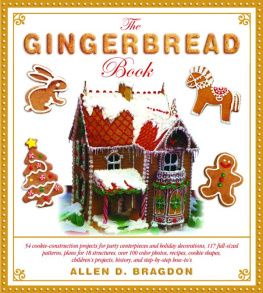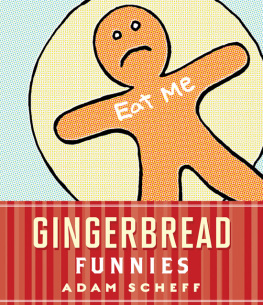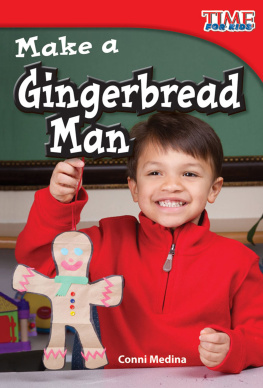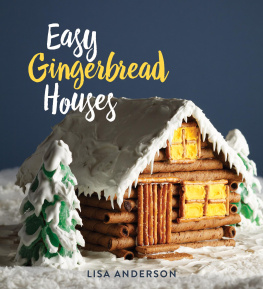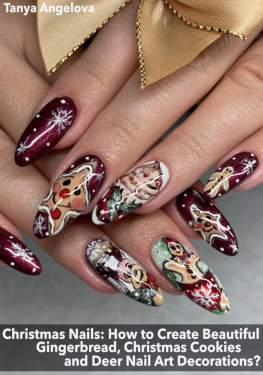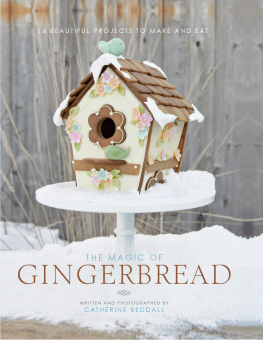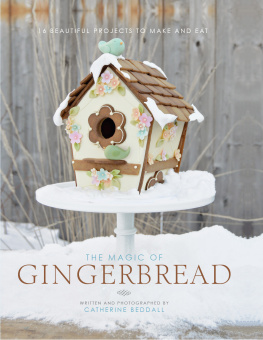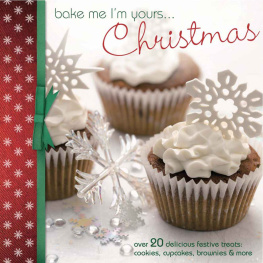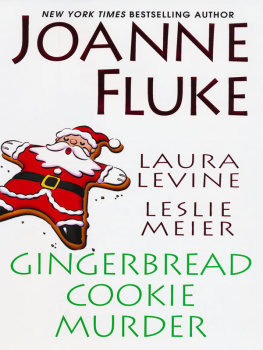
THE
GINGERBREAD
BOOK
THE
GINGERBREAD
BOOK
54 cookie-construction projects for party centerpieces and holiday decorations, 117 full-sized patterns, plans for 18 structures, over 100 color photos, recipes, cookie shapes, childrens projects, history, and step-by-step how-tos
Allen D. Bragdon

Skyhorse Publishing
Copyright 1984, 2011 by Allen D. Bragdon
All Rights Reserved. No part of this book may be reproduced in any manner without the express written consent of the publisher, except in the case of brief excerpts in critical reviews or articles. All inquiries should be addressed to Skyhorse Publishing, 307 West 36th Street, 11th Floor, New York, NY 10018.
Skyhorse Publishing books may be purchased in bulk at special discounts for sales promotion, corporate gifts, fund-raising, or educational purposes. Special editions can also be created to specifications. For details, contact the Special Sales Department, Skyhorse Publishing, 307 West 36th Street, 11th Floor, New York, NY 10018 or .
Skyhorse and Skyhorse Publishing are registered trademarks of Skyhorse Publishing, Inc., a Delaware corporation.
www.skyhorsepublishing.com
10 9 8 7 6 5 4 3 2 1
Library of Congress Cataloging-in-Publication Data is available on file.
ISBN: 978-1-61608-490-5
Printed in China
Photography
All photography by Laszlo Studios, New York, except the following: OrnamentsBird by Frank Moscati; Chanticleer, Austrian I.H.S., St. Nicholas by Peter Brandl. Real EstateCandy Cathedral and Cookie Hall by Louis Lichtman; Bavarian Chalet by Peter Brandl; all others courtesy of Historic Strasburg Inn, Lancaster County, PA. CoverPhoto by Laszlo, reprinted courtesy of Modern Maturity magazine and Karo Corn Syrup.
Acknowledgements
The following individuals and other sources contributed recipes: Sybil Claiborne; Early American Life magazine, December 1983; Argo and Kingsfords Corn Starch; Karo Corn Syrup; Graff, Pfeffernuss and Mandelkern; Mystic Seaport Cookbook; The Pomona Grange; Spicer, From an English Oven; Aline Steyer.
Contents
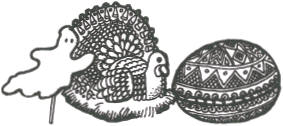
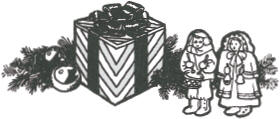
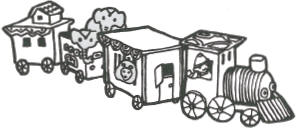
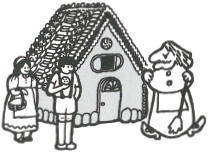
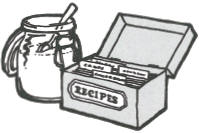
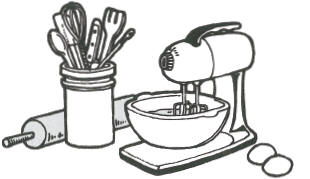
Introduction
The best thing about gingerbread, like affection, is the sharing. People create gingerbread houses to make other people smileeven construct them with the help of other people sometimes.
Another gentle fact about gingerbread is that its ingredients and the tools one needs do not cost much. Memorable gingerbread houses are made with patience and imagination, not with expensive equipment. Fortunately, gingerbread construction is not yet one of the popular TV sports. (Those often make the personality of the doer more important than the thing done, or lead people to believe that the gleaming equipment they buy is more important than the quiet time they take to try doing something well. That just is not so.)
Also, there is something historically mysterious about gingerbreadits like honey that way. Ginger, and cookies flavored with it, have been appearing in accounts of ordinary peoples daily lives since the beginning of written history.
Decorative shapes seem always to have been part of the picture. Because the commanding flavor of ginger attracts the palates attention so forcefully, the creator of the cookie can let flavor take care of itself and express a personal touch in the decoration.
A gingerbread house is not just a square cookie with a roof. It is a three-dimensional chuckle of appreciationa focus for feeling good. Even Hansel and Gretels witch knew that. In fact, the dramatic surprise of Hansel and Gretels predicament is that gingerbread has always been for friends. Nobody wants to make a batch of cookies, shape them, decorate them with frosting, arrange them on a pretty plate, then sit down and eat them all alone. Well, almost nobody.
A warm, thick, steamy-dark cake-pan of gingerbread right out of the oven, cut quickly into cubes, lifted out onto plates, and served up with a fork and a pitcher of lemon sauce, thats what memories are made ofso were those tingle-tongued, snapping-crisp ginger cookies made by your grandmothers sister because she knew you might come to visitand so was the first gingerbread house you ever saw, lovingly made and put out on the table where you could see it when you walked in the door. Those are things people do because they, privately and personally, want someone to grin. This is so personal a medium, gingerbread, that it is almost a shame to make a book about it.
Still, a memorable party is worth a thousand words, and with luck, there may be some ideas in here you can use to broaden a smile. Like any written-down collection compiled by experts for interested peers, at the very least this book will be a stimulating place to take off from toward a refreshing idea of your own thats going to be worth the doing. We hope your children like the fairy tales.
Allen Bragdon, Editor
The History of
Gingerbread
It has been baked in Europe for centuries. In some places, it was a soft cake, in others, a brittle cookie. It was sometimes light, sometimes dark, sometimes sweet, sometimes spicy, but almost always it was cut into shapes and colorfully decorated, or stamped with a mold and dusted with white sugar to make the impression visible. We have inherited gingerbread from many old times and many old places and its history is filled with traditions we have made our own.
TAKE ME TO THE FAIR
If you lived in London in 1614, your family would have gone to the Bartholomew Fair on August 24th. You might have gone there to buy a winters worth of cloth, but the children would have tugged you to the puppet show, begged you to let them see Lantern Leatherheads hobbyhorses and toys, and scampered among the carts and trays of the noisy, wandering costermongers looking for one special peddler. Then they would hear her cry:
Buy any gingerbread!
Gilt Gingerbread!
There she was, Joan Trash, the gingerbread woman! The children would run up to her, peek over the rim of her basket, and their eyes would widen at what they saw: little gilded figures of men, women, animals, saintsespecially many of St. Bartholomew, whose feast day the fair celebratedall in gingerbread! You surely would have bought some of the gingerbread womans wares. But if you had been nearby a few moments earlier you would have heard the hobbyhorse seller muttering to anyone within earshot that Joan Trashs gingerbread was made with stale bread, rotten eggs, musty ginger, and dead honey. If you lived in 1614, you would have known the recipe to be accurate but would have shrugged off the insult.
Next page
